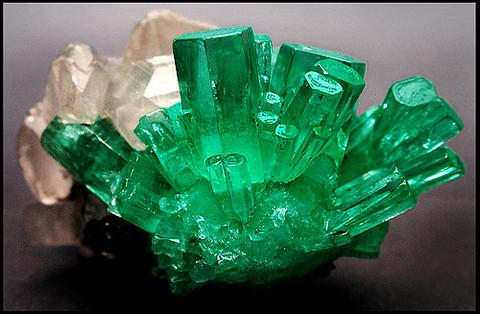No products in the cart.
Leafy green to dark green gem material colored by traces of Chromium and sometimes along with Vanadium is known as Emerald. It falls under Beryl family and has a habit to grow as hexagonal columnar pipes and sometimes found as twinned crystals.

Emerald as the birthstone for May, is a symbol of rebirth. It is believed to grant the owner foresight, good fortune, and youth.
Emerald word is derived from the word `Smaragdus’ meaning “green” in Greek. It is also derived from Spanish word “Esmeralda’’ which means Emerald.
Emerald has been synonymous with the color green since ancient times. A fine emerald is a truly breath-taking sight and hence it deserves its placement among the traditional “Big Five” gems along with Pearl, Diamond, Ruby and Sapphire.
Emerald is a birthstone for Zodiac Cancer representing planet Mercury as per Indian astrology.
The physicoptics are as follows:
Color: Deep to medium green, blueish green.
Crystallography: Hexagonal
Hardness: 7.5-8
Major Sources: Colombia, Brazil, Zambia, Zimbabwe, Madagascar, Nigeria, Pakistan, Afghanistan, India, Russia and others.
Specific Gravity: 2.67-2.78
Unusual Variety: Trapiche Emerald from Columbia.
Most emeralds are kept in oil, preferably non dyed oil. This oil enters multiple of fissures inside emerald as emerald is a softer beryl variety which on exposure to heat, loose oil or and fissures become visible spoiling beauty of the emerald pieces.
Nowadays, many stones with different types of treatments which increases the transparency and hence the beauty of emerald pieces. This type of emerald needs declaration of treatment done to buyer. These treatments are: Dyeing, surface coating, resin filling, waxing, plastic impregnation and non- dyed/ non colored oil. Oiling is universally accepted treatment for emeralds. Still some European countries ask for specific oil certification used as oiling for emerald.
All green looking similar to Emerald acts as its Simulants. Most used cheaper version of simulant is Clear quartz topped Triplets which are widely used in Indian local market in high end gold jewellery.
Emerald is traded as cut & polished stones, strings, carvings and cabochons. Victorian jewellery has cabochons while modern jewellery uses faceted stones.
~~~~~~~~~~~~~~~~~~~~~~~~~~~~~~~~~~~~~~~~~~~~~~~~~~~~~~~~~~~~~~~~~~~~~~~~~~~
Rajesh Patel is a gem blogger and deals in compliant colored gemstones based in Andheri, Mumbai.